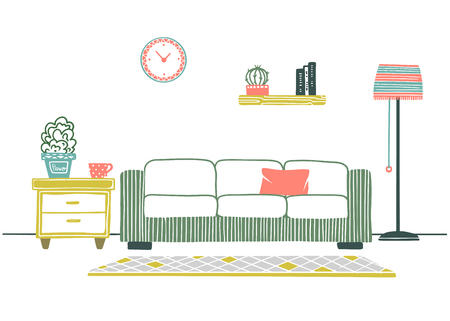Introduction to Interior Design Services in Britain
In recent years, the landscape of interior design in Britain has witnessed a significant transformation, blending heritage charm with innovative approaches. Traditionally, British homeowners have valued in-person interior design services—meeting with designers face-to-face to discuss visions, mood boards, and materials that reflect the unique character of their homes. However, as digital technology continues to evolve and shape consumer habits, there has been a remarkable surge in virtual interior design services across the UK. This emerging trend allows clients to collaborate remotely with professional designers from all corners of the country, bringing flexibility and accessibility to the forefront. From classic Victorian terraces in London to contemporary flats in Manchester, British residents are now navigating between these two distinct modes of service. As we delve deeper into this comparison, it is essential to understand how both virtual and in-person options cater to the diverse needs of Britain’s style-conscious homeowners while influencing the way spaces are imagined and transformed.
2. How Virtual Interior Design Works in the UK
Virtual interior design has swiftly gained popularity across Britain, adapting to the nations distinctive tastes and lifestyle needs. In essence, this digital service allows homeowners and renters alike to collaborate with professional designers from the comfort of their own homes—no matter whether you live in a London flat or a countryside cottage.
An Overview of the Virtual Design Process
The journey typically begins on a British-based platform such as My Bespoke Room or Topology Interiors. Clients are invited to complete a detailed questionnaire outlining their style preferences, budget, and project scope. After submitting measurements and photographs of their space, clients may participate in video consultations via Zoom or Teams, during which designers gather further insights and clarify expectations.
Key Technologies Utilised
| Technology | Application in UK Market |
|---|---|
| 3D Visualisation Tools | Enables realistic renderings tailored to British layouts and period features |
| Augmented Reality Apps | Lets clients preview furniture and décor virtually within their own rooms |
| Online Mood Boards & Sample Libraries | Curated selections reflecting UK trends, suppliers, and local artisans |
| Secure Messaging Platforms | Ensures GDPR-compliant communication between client and designer |
The Typical Client Experience in Britain
The client journey is intentionally streamlined for convenience—a priority highly valued in British culture. After an initial consultation, designers present mood boards, floor plans, and shopping lists featuring products from trusted UK retailers like John Lewis or Habitat. Clients receive guidance on sourcing items locally or through recommended online stockists. The process is collaborative yet flexible; clients can request revisions digitally, making it easy to accommodate busy schedules or last-minute changes common in British households.
British Expectations & Etiquette
Bespoke attention is key: most British virtual design services pride themselves on understanding period properties, maximising compact spaces, and respecting heritage features. Communication is typically formal yet friendly—expect regular email updates and prompt responses during working hours. Overall, the virtual approach offers an accessible, time-efficient route to achieving a beautifully curated home that feels distinctly British.

3. Traditional In-Person Interior Design: A British Perspective
When it comes to interior design in Britain, the traditional in-person approach is more than a service—it’s a cultural experience steeped in heritage and personal connection. Many British homeowners value the face-to-face relationship with their designer, relishing the opportunity for collaborative discussions over cups of tea, site visits, and tactile exploration of materials. This classic method allows designers to immerse themselves fully in the architectural quirks of British homes, from Victorian terraces to country cottages, ensuring that every detail—from cornicing to skirting boards—receives thoughtful attention.
The Importance of Context and Character
British interior design is closely tied to context; designers must consider historical elements, period features, and local building traditions. In-person consultations enable designers to read a space’s atmosphere, pick up on subtle cues from natural light and texture, and build rapport with clients. This sensitivity to context helps preserve the unique character of each property while weaving in contemporary comforts.
Personalised Service Rooted in Tradition
The bespoke nature of traditional British interior design means solutions are highly tailored. Designers often source locally crafted furnishings, vintage pieces, or custom joinery to complement a home’s story. The process typically involves several site visits, hands-on mood board presentations, and ongoing collaboration—hallmarks that many British clients see as integral to achieving an authentic and harmonious result.
Cultural Preferences: Trust and Craftsmanship
Trust plays a pivotal role in these relationships; British clients often prefer working with designers who demonstrate a deep understanding of both regional aesthetics and timeless craftsmanship. The tactile engagement—feeling fabrics, viewing paint samples under natural daylight—reinforces confidence in decisions. For many, this tangible interaction is irreplaceable, making the traditional approach not just about design but about celebrating British heritage within every bespoke space.
4. Key Differences: Virtual vs. In-Person Design
When considering interior design services in Britain, it’s crucial to understand how virtual and in-person approaches diverge in their workflow, communication styles, levels of personalisation, and flexibility. Each method brings unique strengths and limitations, especially within the context of UK homes—ranging from compact London flats to Victorian terraces and countryside cottages.
Workflow Comparison
| Aspect | Virtual Design | In-Person Design |
|---|---|---|
| Initial Consultation | Online forms, video calls, digital surveys | On-site visits, physical walkthroughs |
| Site Assessment | User-submitted measurements & photos | Professional measurements & direct assessment |
| Design Proposal | Digital mood boards, 3D renderings emailed or shared online | Tangible samples, physical mood boards presented on-site |
| Implementation Support | Email/phone check-ins; occasional video guidance for DIY-friendly solutions | Hands-on project management, sourcing, and coordination with local craftsmen/tradespeople |
Communication Styles in the UK Context
Virtual design services rely on clear, concise digital exchanges. British clients often appreciate timely emails with detailed summaries and visual aids. However, the lack of face-to-face nuance can sometimes lead to misunderstandings regarding subtle preferences or historical property quirks typical in UK housing stock.
In-person designers offer a more personable approach. Conversations during home visits allow for spontaneous feedback and a deeper understanding of local lifestyle needs—such as maximising limited space in urban settings or respecting period features in heritage homes.
Personalisation Levels: Tailoring to British Lifestyles
While both models promise bespoke solutions, in-person designers typically achieve a higher degree of customisation. They’re able to sense textures, lighting conditions (a key factor given Britain’s variable climate), and spatial flow firsthand. Virtual services are improving rapidly thanks to advanced software and virtual reality tours but may miss nuanced details like the interplay of natural light on original cornicing or the tactility of locally sourced materials.
Flexibility: Adapting to Modern British Living
| Virtual Design | In-Person Design | |
|---|---|---|
| Pace & Scheduling | Highly flexible; suitable for busy Londoners or remote homeowners. Sessions can be slotted around work-from-home routines. | Requires fixed appointments; better suited for those able to accommodate multiple site visits. |
| Geographical Reach | No regional restrictions; ideal for rural or hard-to-access properties across Britain. | Mainly localised; best for clients seeking connections with trusted local suppliers. |
| Adaptability During Project Changes | Easier document sharing and iterative updates online. | Smoother on-the-fly adjustments during site visits or installations. |
The choice between virtual and in-person design hinges on individual priorities—whether you value the convenience of online collaboration or the tactile assurance of a designer physically present within your unique British space.
5. Cost, Accessibility, and Convenience for British Clients
When considering interior design services in Britain, the factors of cost, accessibility, and daily convenience play a pivotal role in shaping client decisions. Virtual interior design has introduced a shift in pricing structures; many UK-based platforms offer transparent flat-fee packages or hourly rates that are typically lower than traditional, in-person services. This affordability appeals to first-time homeowners or those seeking budget-conscious renovations. In contrast, in-person designers often charge by the hour or as a percentage of the overall project cost, reflecting both their expertise and the time spent on site visits, sourcing local materials, and managing contractors.
Regional Accessibility Across the UK
Britain’s diverse geography—from bustling London boroughs to remote Scottish Highlands—can influence service accessibility. Virtual design eliminates geographical barriers; clients from Cornwall to Inverness can engage with top-tier designers without travel constraints. Conversely, in-person services may be limited in rural areas or require additional fees for extended travel, making them more accessible in urban centres like Manchester or Birmingham.
Convenience in Everyday British Life
The day-to-day convenience of virtual design is particularly attractive for busy British professionals and families juggling work-life commitments. Online consultations can be scheduled outside standard business hours, while digital mood boards and 3D visualisations provide instant feedback. In-person design still holds unique appeal for those valuing tactile experience—touching fabrics at a Chelsea showroom or walking through a designer’s proposal within a Victorian terrace. However, it requires greater time investment, often involving multiple home visits and coordination with local tradespeople.
Weighing Up Your Options
Ultimately, choosing between virtual and in-person interior design in Britain comes down to weighing upfront costs against personalised attention and considering how each service fits your lifestyle and location. For some UK residents, virtual solutions unlock new creative possibilities and flexibility; for others, the hands-on approach remains an irreplaceable part of transforming their living spaces.
6. Which Option Suits British Homes and Lifestyles Best?
When deciding between virtual and in-person interior design services in Britain, it is essential to reflect on the unique characteristics of your home and your lifestyle requirements. British homes often range from charming Victorian terraces to contemporary flats, each offering distinct spatial challenges and opportunities for creative expression.
Traditional Homes with Heritage Features
If you reside in a period property or a listed building—common across many British cities—the tactile expertise of an in-person designer can be invaluable. Navigating original fireplaces, ornate cornices, or sash windows often requires hands-on assessment and direct collaboration with local craftspeople. In such cases, face-to-face consultations ensure that every historic detail is respected and seamlessly integrated into a fresh aesthetic.
Modern Flats and Urban Living
For those in newer developments or city apartments, virtual design services provide a streamlined solution that fits the fast-paced urban lifestyle. These digital experiences are particularly suitable for open-plan layouts where space-saving strategies and multi-functional furniture are key. Virtual consultations allow busy professionals to access expert advice flexibly, without sacrificing style or substance.
Lifestyle Considerations: Family, Pets, and Work-From-Home
The British home today often serves as both sanctuary and workspace. Families with young children or pets may benefit from in-person visits, where designers can better appreciate practical needs—durable fabrics, clever storage, or child-proofed corners. Conversely, remote workers might favour virtual services for their efficiency and ease of scheduling around daily routines.
Aesthetic Priorities: Personal Touch vs. Digital Convenience
If you value a bespoke approach and enjoy tactile experiences—such as sampling fabrics or viewing paint swatches in situ—in-person design fosters deeper creative dialogue. However, if you’re tech-savvy and appreciate mood boards delivered at the click of a button, virtual design offers efficiency without compromising on inspiration.
Making Your Choice: A Practical Guide
Ultimately, the best service model aligns with your home’s architectural character and your personal lifestyle. For heritage-rich properties or complex renovations, opt for in-person expertise rooted in local knowledge. For straightforward updates or contemporary spaces—especially if flexibility is paramount—virtual design brings professional flair directly to your screen. By considering these factors thoughtfully, you’ll ensure your interior project reflects both British charm and modern practicality.


